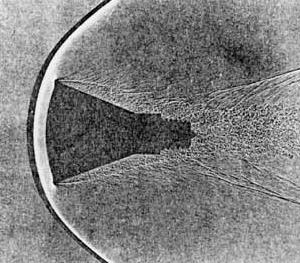This undergraduate level course on High-Speed Aerodynamics teaches the effects of compressibility occurring at high-speeds in internal and external flows with relevance to Aerospace applications. The primary focus of the course is on the teaching of inviscid compressible aerodynamics in nozzles (wind tunnels, gas turbines, rockets), around wings (aircraft, fighter jets, space shuttle) and around blunt bodies (rockets, reentry vehicles). Emphasis will be placed on shock physics and the solutions of theoretical and numerical linearizations of the governing flow equations. The course provides fundamental
information that will enable the engineering analysis of the flow characteristics and forces on aircraft, wings and in nozzles at subsonic, transonic, supersonic and hypersonic speed.
Syllabus (.doc)
- Course Objectives
Students successfully completing AE302, "High-Speed Aerodynamics" should have:
-
A fundamental understanding of the effect of compressibility at high-speeds and the ability to make intelligent design decisions based on this understanding.
.
- A fundamental understanding of shock formation and dynamics and the ability to estimate the shock location.
- The ability to estimate drag and lift forces on basic aerodynamic (lifting) shapes traveling at high-speed.
- The ability to determine the full high-speed flow field on thin airfoils, wedges, and in nozzles.
- An ability to analyze airfoils at subsonic, transonic and supersonic flight conditions.
- Course Description
The course relies on the textbook "Fundamentals of Aerodynamics" by J.D. Anderson. The course will follow the textbook closely. We will first review some basic thermodynamics and introduce the concept of compressibility (Chapter 7). We will then discuss the formation and analysis of normal shock wave (Chapter 8), followed by a treatment of oblique shock waves (Chapter 9). The compressible flows through converging-diverging nozzles, diffusers and wind tunnels is the next subject (Chapter 10). We then discuss the shock-expansion theory to determine flow over sharp edged
airfoil geometries, followed by a presentation of potential flow over
over thin airfoils (Chapter 12). We will introduce some numerical solution techniques to compute compressible flows (Chapter 13), and finish (if time permits) with a brief discussion on hypersonic aerodynamics.
- Textbook
Anderson, J.D. Jr., "Fundamentals of Aerodynamics", 4th Edition, McGraw-Hill, 2007.
- Supplementary Textbooks
Compressible Flow:
- Anderson, J.D., "Modern Compressible Flow: With Historical Perspective", McGrawHill, 2002.
- Zuker, R.D., and Biblarz, O.,"Fundamentals of Gas Dynamics", John Wiley & Sons Inc., 2002.
- Thompson, P. A. Compressible Fluid Dynamics. Maple Press Company, 1984.
- Saad, M.A.,"Compressible Fluid Flow", Prentice-Hall, 1993.
- Liepmann, H., and A. Roshko. Elements of Gas Dynamics. John Wiley Publishers, 1957.
Computational Fluid Dynamics:
- Anderson, J.D., "Computational Fluid Dynamics: The Basics with Applications", McGrawHill, 1995.
- Katz, J. and A. Plotkin. Low-Speed Aerodynamics: From Wing Theory to Panel Methods. New York, NY: McGraw-Hill, Inc., 1991.
General Fluid Mechanics:
- White, F.M., "Viscous Fluid Flow", McGrawHill, 1991.
- Schlichting, H., Gersten, K., "Boundary-Layer Theory", 8th edition, 2004.
- Prerequisites
Students are expected to have a basic understanding of calculus, elementary physics, thermodynamics (ME352), and fluid mechanics (AE301).
- Homework Problems
A total of approximately eight problem sets will be given on Wednesdays. The due date for submission of assignments is at the beginning of class (depending on the size of the homework) the Wednesday after the assignment is given. Late submission of assignments is not accepted.
- Exams
There will be one midterm and one final written examination.
- Course Grade
The grading will be based on a weighting of 25% on the homework, 35 % on the midterm exam, and 40 % on the final exam.
Performance is assessed based on
- The skill to solve given problems
- Clarity of the motivation of the steps involved in solving a problem
- Clarity of the presentation of the results.
Each of these three point carry equal weight.
- Policies
Regular and punctual attendance and participation are expected. Absence from tests must be explained with medical certificates or other valid reasons beyond your control and planning. Ask anyone for help on homework, but what you submit must be your own work.

